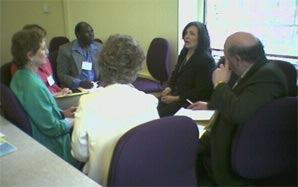Scholarship of Teaching and Learning
I'm at the Middlesex Carnegie Summer Institute & New England Faculty Development Consortium, which is being held at the Middlesex Community College's Lowell campus. Right now am running on a wireless connection which I hope continue to maintain its signal strength.
Anyway thought I would try blogging some of the sessions to see how effective this is. The first session is called Bridging the Gap An Educational Assessment model that Integrates Technical and Professional Development,
and is being presented byLornaa Hayward and Betsy, professors of Physical Therapy Northeastern University in Boston.
I'm hoping that this will be useful for both my nursing and now culinary instructional design.
The focus is going to be on authentic learning and how to provide tangible evidence of the learning. They have created pedagogy that explicitly teaches and rewards students".
Model revolves around a Standardized Patient. laypeople are recruited to emulate aspecifici problem. Students then work with therecruitedd people who are trained to act in the same way for a certain problem. Lay patients are trained to express primary signs &symptomss of the disease they are supposed to have. Thelaypeoplee can provideaffectivee feedback about how the students interacted with the layperson "patient". Interaction is videotaped. Students do self-assessment as well as get peer-assessment.
Learning communities provide other part of model. Belief that learning is enhanced and actually changes as a result of working with others. Students work in small groups online using BB discussions. Students know case in advance, questions are posted and in the group they prepare for the upcoming interaction with the patient (layperson). A faculty mentor facilitates the group to ask guiding questions if necessary.
Assessment involves 360 assessment using feedback from instructor, peers, Standard Patient (SP), self, videotape, plus a debriefing. they use rubrics for affective, cognitive, and performance domains.
One of the problems with the model initially was the challenge of training SPs. Older people were found to be very good SP. Training was one hour and then to commit to being a SP twice, including providing feedback to students and faculty. SPs were paid with $50 Barnes & Noble gift certificate, although many did not accept the pay and wanted to do it to contribute themselves to the university.
I like the questions that they provided to guide in reflections.
Reflections:
What was it — what did you learn?
Why was it important - what did it trigger in you?
So what? - what are you going to do with this new epiphany?
Then we broke into small groups

to discuss a couple of different sets of questions relating to the pedagogy just described. What I learned, or the AHA that I have came from Tom T. who is at Rode Island Institiute of Technology. He said he realized that even though they have video classes, they don't use video to do formative assessment. The students turn in a final project that is a video, but Tom had the realization that they could also be using video to tape the process of making the video. In fact, they could have one group taping the assignment, and then a second group videotaping the group who was taping.
It strikes me that there is something in here that I might also be able to use in my teaching. I'll need to think a bit more about it though.
Technorati Tags: pedagogy Standard Patient assessment SoTL






0 Comments:
Post a Comment
<< Home